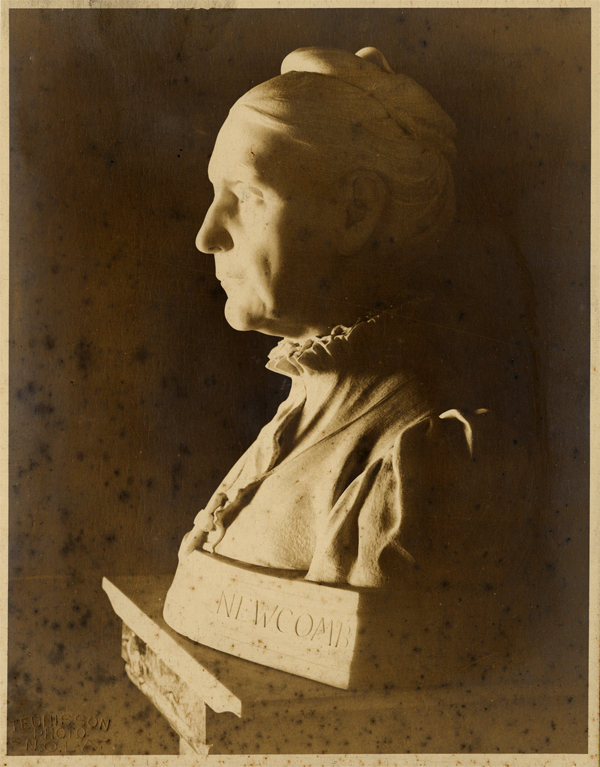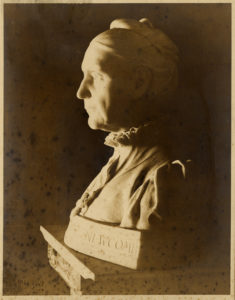Josephine Louise Le Monnier Newcomb
Benefactor of Newcomb College whose life was marked by grief and whose legacy was marked with conflict

Courtesy of Louisiana State Museum
Josephine Louise Le Monnier. Teunisson, John N. (photographer)
In 1886 Josephine Louise Le Monnier Newcomb donated funds toward the founding of the H. Sophie Newcomb Memorial College. She made this gift in memory of her “beloved daughter,” who died in 1870 at age fifteen. The college would be part of Tulane University in New Orleans from 1887 to 2006.
Newcomb’s gift was both intentionally modest (“… small enough to allow additions in case of success”) and place specific. With $100,000, Tulane administrators worked to establish a coordinate college, or women’s college, within the all-male university. Newcomb College became the first such arrangement in the United States to grant degrees. Newcomb specified that the college be for “white girls and women,” thus aligning it with the Southern politics of segregation. She also asked that “the education given … look to the practical side of life as well as to literary excellence.”
These stipulations reflected Newcomb’s life experiences. She was born Josephine Le Monnier in 1816, in Baltimore, Maryland, the daughter of Mary Sophia Waters, a first-generation American of English descent, and French-born Alexander Le Monnier, who sold, not always successfully, what were called ‘French goods’ and included ribbons, lace, and buttons. After her mother’s death in 1831, fifteen-year-old Le Monnier joined other family members in New Orleans. There, brother Victor Le Monnier invested in a patent for a biscuit-making process and a bakery. Some of her extended family were wealthy and owned enslaved persons, and all the relatives benefitted from the broader slave economy. Le Monnier made her home with her older sister and brother-in-law, who was part owner of a ceramic import firm.
One summer in Kentucky, where they went to escape heat, Le Monnier met Warren Newcomb, a prosperous partner in a family-owned wholesale grocery and liquor firm, one that also benefitted from the slave economies in various states as well as from the growth of the Midwest. Le Monnier and Newcomb married in 1845. Unlike others in their families, the Newcombs never had their own permanent residence, preferring instead to live in hotels or in the homes of relatives. A son died soon after birth in 1853, and daughter Sophie was born in 1855 in New York.
The Newcombs would spend some of the Civil War years in New York and in Europe. All the same, Josephine Newcomb always described herself as a “Southern woman,” and Massachusetts-born Warren Newcomb gave money to establish a scholarship at Washington College (later Washington and Lee) out of respect for Robert E. Lee.
Warren Newcomb died in 1866, leaving behind an estate of approximately $650,000. This death, followed so quickly by Sophie’s of diphtheria in 1870, influenced Newcomb to move from hotel to hotel, boarding house to boarding house, and city to city even more than she had as a married woman. As Newcomb described herself then, she was a “wretched woman.”
Still, as Newcomb’s wealth grew, she oriented herself towards philanthropy. First, at Washington College, she conferred with ex-Confederates George Washington Custis Lee and William Preston Johnston to erect a building in her husband’s name and to continue her involvement in the scholarship he had given there. She also provided money to individuals, churches, and groups concerned with water purity, the education of the deaf, nursing, and Confederate orphans.
New Orleans’s Ida Slocumb Richardson, a promotor of many causes, knew of Newcomb’s gifts and of her desire for a more permanent memorial in Sophie’s name. Richardson suggested several local charities and various reform efforts that she discovered during the 1885 World’s Industrial and Cotton Exposition in New Orleans. Richardson also, by chance, reminded William Preston Johnston, Tulane’s then-new president, of Newcomb’s search.
Johnston contacted Newcomb in early 1886, and within months, she offered assistance towards his goal of women’s education within Tulane. His vision centered on academic and vocational courses, a duality that matched Newcomb’s life experiences. Although hardly anything is known of her own education, she valued reading and, within it, “literary excellence.” Books were among the few items that traveled with Newcomb from one transient place to another. And, especially after her husband’s death, she found herself embroiled in fights with male family members while, at the same time, being dependent on them. She was thus mindful of limitations on women and of the need for practical learning.
Various friends and family members served as examples of this balance of both types of education. One such friend was writer Sallie Brock Putnam whose book Richmond During the War (1867) recounted experiences of nursing in the Confederate capital. Another friend was Elizabeth Mills Chamberlain, whom Newcomb met when she first gave money for New York’s St. Ann’s Church for Deaf Mutes, where Chamberlain’s husband was assistant rector. Chamberlain had studied painting abroad and took her skills seriously. Among her New Orleans relatives, Newcomb’s cousin Harriet Zacharie Hardee was a self-sufficient woman, serious about hands-on matters. As a widow Hardee became a metal adjuster and later forewoman at the US Mint, one of the few places to hire women.
In the college Newcomb could envision a place where her daughter’s life gave paths to other women, going forward “as if” she lived again. In 1899, Newcomb bought a New Orleans home that backed up to the Washington Avenue campus, her first conventionally permanent home since childhood. That said, true to her own life patterns, Newcomb died April 7, 1901, at the home of the Chamberlains in New York City. By this time Newcomb had given more than $3.6 million to benefit the women’s college. She ultimately gave a much larger gift than that given by Paul Tulane, the university’s namesake benefactor.
At various times in the college’s history, Newcomb’s intents were examined and some of them changed. Her sister’s children challenged her will and her sanity in court cases from 1901–1908, losing their battle. Her stipulation of a segregated white school was changed in 1962, with the first African American student enrolling in 1963. Her will was the key document in the 2006–2011 court battle over the closure of the college, won by Tulane University.
Still, the long list of successful Newcomb College alumnae and the present Newcomb Institute stand for Newcomb’s original pursuit of a living memorial to her daughter. The funds, she said, “would go on year by year doing good. Such a memorial … [remains] better than statues or monuments.”
